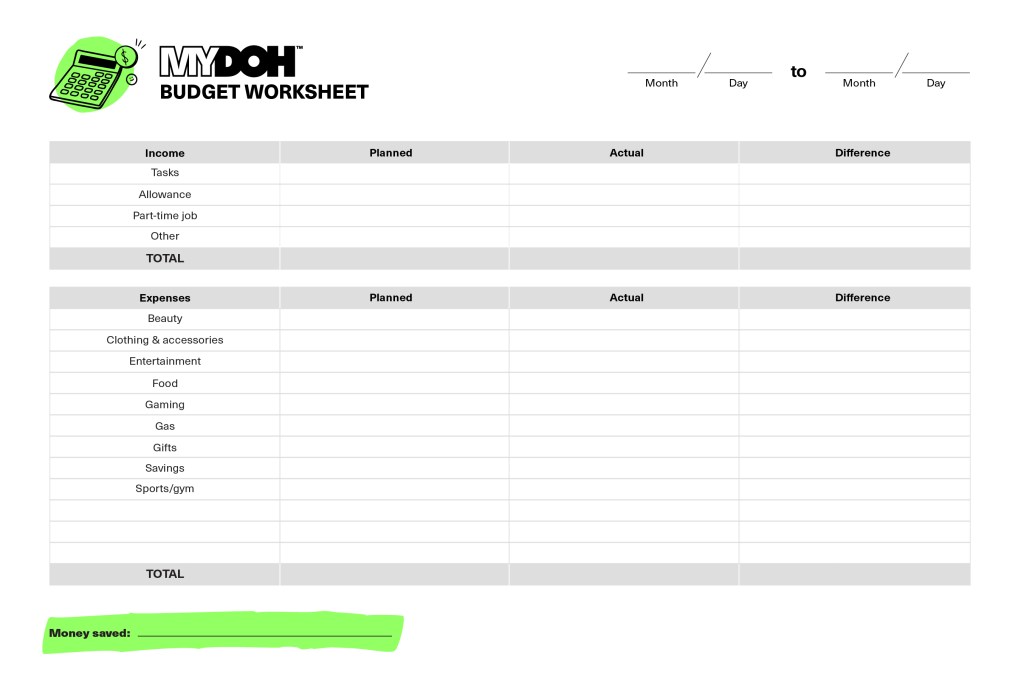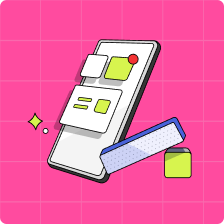Parents, you remember that feeling when you’re pretty flush at the beginning of the week, but by the weekend you aren’t sure where all the money went? Staying on top of every dollar coming in and going out of your budget can be tricky. And if you feel this way, chances are your money-earning teen feels the same way, too.
Budgeting isn’t something that necessarily comes naturally to kids—and, let’s face it, this skill can also be hard for adults. But as a parent, one of the best things you can do for your teen is to impress upon them that they’re in control of their own money, and a budget calculator is a great tool that makes it easy to stay on track. Here’s how to talk to your kids about the importance of a budget, the benefits of using a budget calculator, and how to access free budgeting tools and worksheets that can make life easier.
Key takeaways
- Having a budget means tweens and teens learn to make a plan with their money, save toward a goal, and avoid unnecessary spending (and debt!).
- A budget calculator makes it easy to track saving and spending habits and helps identify areas where they could spend a little less and save a little more.
- A budget calculator is a basic tool: income minus expenses, month after month.
- The best budget calculator is the one you can stick with.
- Teaching tweens and teens how to use a budget calculator helps them become more comfortable budgeting and managing money as adults.
Why is a budget important?
Two of the best reasons for kids to plan a budget are so they can start to identify between wants and needs (i.e., upgrading to the latest smartphone versus a raincoat), and also stay in the black—meaning, debt-free. Your tween or teen may think it’s a bore to talk about creating a personal budget, but you also don’t want them assuming their parents (i.e., you!) will be funding their life’s journey. Your job is to open their eyes to all the benefits of budgeting. And because kids living at home usually have minimal expenses to worry about, now is the best time for them to practise their own budgeting skills.
Let’s say they have a part-time job or get a weekly allowance. If they aren’t careful about tracking their money now, poor spending habits may land them in debt later on. This means they’ll have to work more to pay off their debt, with less time to actually enjoy their money.
Second, paying attention to their finances and prioritizing where money is being spent helps teens achieve their goals—whether it’s going to the movies with friends tomorrow, or purchasing new Chuck Taylors next month. And by setting a budget, it’s easier to spot smaller spending problems as they come up—and before they become bigger hurdles.
The takeaway: If teens have a budget plan in place, they are more likely to always have money for what they need and hopefully enough to buy the extras they want. Right now, that’s anything from a frosty iced coffee to a gym membership. But in the future, it could be a new car or the vacation of a lifetime.

What is a budget calculator?
Basically, a budget calculator is a simple tool that tracks the math of money coming and going. It can help your tween or teen build a financial plan that’s easy for them to follow and maintain. The best part of a digital budget calculator is, all the addition and subtraction is done for you, so you don’t have to sit down with a pad and pencil or even use an actual calculator (unless that’s your thing!).
One big bonus of using a budget calculator is that it’s easy to see where you’re spending cash and also where areas like savings and investments can be improved. A budget calculator adds up what’s coming in every month (i.e., income or an allowance), then deducts all the money going out (i.e., expenses), showing any remaining dollars for the month. After a few months of using a budget calculator, your teen should start to see patterns, good or bad, which can help them take steps toward meeting a savings goal.
How do you use a budget calculator?
Using a budget calculator is relatively simple: enter income, then deduct expenses. Monthly calculations are easiest to start, but you can gain more accuracy with added details. Biweekly (every two weeks), weekly, or even daily calculations can help paint a very clear picture of personal spending and saving habits:
- Enter your income: If your tween or teen has a steady part-time summer job or allowance, this part is fairly easy. Or, if their income varies month to month, they can calculate their average income over a few months.
- Enter repeated expenses: For adults, these may include things like rent or mortgage, car payments, insurance, utilities, and groceries. For tweens and teens, recurring expenses might be transportation, phone bills, clothing, entertainment, and personal care. If some of these expenses vary from month to month, they can calculate an annual approximation and divide that number by 12.
- Enter one-off expenses: Track every one of those little indulgences, whether it’s after-school lattes, a movie download, or a fun new accessory. This will help your teen discover a pattern or a spending habit they may not even be aware of.
Once these calculations are done, it’s easy to see how much money is left over for spending, saving, or applying toward debt. As time goes on, a budget calculator will show you how it’s actually going, so that some spending habits can be tweaked, if needed.
A budget calculator can also help teens identify needs over wants. And, if there’s a financial shortfall, they can quickly see where spending can be reined in to reach a goal.
Free budgeting tools and worksheets for kids and teens
There are many free online budgeting tools and worksheets for kids (and adults) to stay on top of finances. Here are some worth testing out:
1. The Budget Planner from the Government of Canada
If you think this government-created budget planner will be clunky and boring, think again. This free tool from the federal government offers a customized budget plan that takes only three steps to set up. Fun factors include loads of budgeting tips, pop-up alerts, and badges kids can earn. And thanks to government data, you can even compare your budget to the average Canadian’s.
2. Budget-planning apps
A number of budget calculator apps are available for free (with optional in-app purchases). Get your kids to help search for apps with a simple design that are easy to use, making it more likely that your teens will stick with them long term. Some top choices are Buddy, Mint, and Fudget.
3. Mydoh’s budget savings calculator
Our free and simple budget savings calculator does the math for teens and kids. They can use the calculator to see how long it’ll take to save for items on their wish list (whether it’s a new gaming console or a second-hand car). Simply input any savings, weekly income, spending, and they’ll receive a personalized savings plan to help them reach their goals.
4. Budget calculators from Practical Money Skills Canada
Teens can select from an array of detailed budget calculators on this website, depending on their goal. The Travel Budget Tool, for example, gets into the fine details of flying over driving, number of nights away, meal costs, luggage costs, currency exchange, and more. Financially motivated kids may want to check out its Save a Million calculator, too.
5. Printable budget worksheets
Tweens or younger teens may want to start smaller with a simple monthly budget calculator they can fill in by hand. A quick online search will show dozens of free downloadable budget worksheets you can print at home, from cute and colourful to minimally designed. If one style of worksheet doesn’t suit your teen, just print off a different one the next month until they find a system that works.

Tip: Kids can download Mydoh’s free budget worksheet to track their spending.
6. A good old spreadsheet
It’s the OG budget calculator, after all! Your teen may enjoy setting up their own spreadsheet in Google Docs or some other software on their computer, then customizing their budget calculator for their specific wants, needs, and savings goals. Some programs also have personal budget templates that come with pre-set categories to save on time and effort, too. Or, you can find downloads that will integrate budgeting strategies with your spreadsheet program, such as zero-based budget templates for Google or Excel, for instance.
Note: While downloads are often described as “free,” they may ask for your email address in exchange.

What are the benefits of using a budget calculator for teens?
The key advantage of using a budget calculator is that it makes following a budget easier, plus it’s an eye-opener for teens to see exactly where every dollar is going. A budget calculator can also show them what they’re spending (or saving) in each category, revealing places to make adjustments they may not have noticed before. Knowing what’s coming in and going out gives tweens and teens a sense of control and confidence—it’s fun for kids to see savings grow when they’re looking to buy a car, for instance, and stay out of debt at the same time.
A simple budget calculator is a great place to start financial literacy with tweens and teens. And remember, your kids watch what you’re doing and how you’re managing your money, too. If you are constantly complaining about how it’s impossible to save money, and how you never have enough, your kids may pick up this vibe and the anxieties that come along with it. So, while you help them set up a budget calculator, perhaps take a look at your own saving and spending habits. That way, you can sit together to take ownership over where you’re spending your money and make a plan to reach your individual goals. As they say, team work makes the dream work!
Mydoh can help by making it easy for kids to pick up practical money skills with fun facts and financial trivia. The Mydoh app also comes with a Smart Cash Card. This helps teens and tweens get used to managing their spending, while also saving toward a goal—all under your supervision, so you can help them build a foundation of financial literacy.
Download Mydoh to help build the foundation of financial literacy for your kids and teenagers.
This article offers general information only and is not intended as legal, financial or other professional advice. A professional advisor should be consulted regarding your specific situation. While the information presented is believed to be factual and current, its accuracy is not guaranteed and it should not be regarded as a complete analysis of the subjects discussed. All expressions of opinion reflect the judgment of the author(s) as of the date of publication and are subject to change. No endorsement of any third parties or their advice, opinions, information, products or services is expressly given or implied by Royal Bank of Canada or its affiliates.








